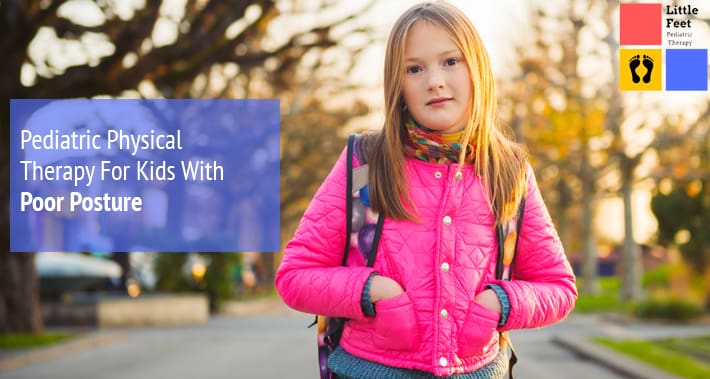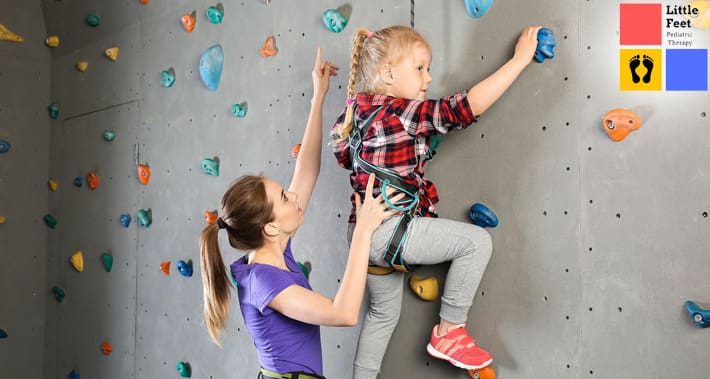
What exactly is posture?
Posture relates to the position someone holds when they are sitting or standing.
Good posture helps support the body and coordinate movements smoothly.
Having untreated poor posture can lead to a number of health and physical issues later on in life and even have impacts currently that are not obvious to the untrained eye.
Have you noticed that your child has poor posture and are concerned that it may cause them issues as they grow up?
If that’s the case, a pediatric physical therapist can help.
At Little Feet Pediatric Therapy, we offer physical therapy to help children improve their posture and prevent potential future complications.
On today’s pediatric therapy blog, we’re going to look at what good posture is, why it’s important, and how physical therapy can help.
Keep reading to learn more.
What Does Good Posture Look Like?
Maintaining good posture has a lot of long term benefits, but what does it look like?
What good posture looks like depends on the position your child holds their body.
Primarily when your child is sitting or standing.
When your child is sitting, their back should be straight and their shoulders back, with their bum in the very back of the chair.
Most importantly, their feet should be touching the floor.
If their feet are dangling, you can place a stool or book under their feet.
Additionally, their hips, knees, and ankles should all be at a 90 degree angle.
This position allows the spine to be in an S position, curving forward at the shoulders and top of the back, and dipping in the lower back.
It’s not unusual for children to lean forward with their heads and shoulders down when sitting at a desk and doing schoolwork.
RELATED: Occupational Therapy For Handwriting
However, they shouldn’t have issues reestablishing good form when they sit back up.
When your child is standing, they should distribute their weight evenly above their hips and feet.
Similar to sitting, their back should be straight and their shoulders back, keeping their chin up.
When standing, all of the main joints of their body should line up in a straight line, from their head down to their ankles.
It’s a good idea to monitor your child’s posture in order to spot any issues that they may have and keep their backs healthy.
Why Is Good Posture Important For Kids?
It’s important for your child to maintain good posture in order to avoid future issues that may develop from improper posture.
Poor posture can negatively affect your child’s joints, muscles, ligaments, and bones by putting more strain on them.
Maintaining poor posture as they grow can lead to awkward positioning, which can cause their spine to grow abnormally.
This also increases their risk of developing arthritis when they are older.
When the joints of their spine are put under continuous strain from poor posture, it increases the risk of developing spine arthritis and joint degeneration.
Poor posture may also lead to feelings of fatigue, shoulder, back, and neck pain, and numbness in the hands.
Maintaining good posture can help your child relax their back muscles, feel more energetic, and prevent muscle and joint pain.
Additionally, a slumped posture makes using your arms and hands more difficult.
This could make writing and eating a challenge.
Lastly, poor posture can also make it harder to take a deep breath, making it harder to adequately breath.
What Causes Children To Have Poor Posture?
There are several factors that can contribute to your child having poor posture.
Children today typically spend a lot of time hunched over when in school or doing their homework.
This is also true from looking at computer screens or smartphones.
Routinely staying in this position may eventually lead to issues related to poor posture.
This may be a primary driver behind why so many children have poor posture these days.
In fact, studies estimate that fewer than 20% of children actually have correct posture.
Another factor may be that your child has underdeveloped postural strength.
This refers to their core strength or trunk control, which helps support their posture.
Medical factors that may lead to poor posture in children include, but are not limited to:
- Spinal conditions like scoliosis, kyphosis, or hyperlordosis
- Cerebral palsy
- Muscular dystrophy
- Obesity
- Autism spectrum disorder
- Ehlers-Danlos syndrome
- ADHD
- Spina bifida
- Idiopathic toe walking
- Sensory processing disorder
RELATED: Frequently Asked Questions About ADHD
Other factors may include:
- Improper sitting position
- Sleeping on an unsupportive mattress
- A heavy backpack with poor ergonomics
- Wearing improper fitting shoes
- Weak stomach, back, and/or hip muscles
- Primitive reflexes that haven’t integrated
Regardless of the cause, physical therapy can help strengthen your child’s weak muscles.
This can help facilitate movement, alleviate joint and muscle strain and pain, and put their body in optimal alignment for breathing, writing, and eating.
How To Improve Your Child’s Posture At Home?
If you’ve noticed your child is struggling to maintain good posture, there are ways you can help them improve their posture at home.
It’s a good idea to gently communicate and demonstrate the ways they can correct their posture.
It may also be beneficial to have them engage in physical activity that helps to strengthen their back and shoulder muscles.
This will allow them to maintain a good posture for longer periods of time.
Let’s take a closer look at some of the things you can do at home to help your child improve their posture.

1. Establish Good Habits With Their Devices Early On
Many of us use our devices by holding them at waist level and hanging our head down to look at it.
Not only is this unhealthy for us adults, it also shows your children to use their devices in this way as well.
The popular term for this is “text neck”, but it’s already a known type of injury, called occupational overuse syndrome.
Whatever you call it, it leads to excessive strain on your (and your child’s) neck.
This can cause chronic headaches, neck pain, shoulder pain, and even difficulty breathing.
More research is needed on the specifics around how this affects posture.
However, it’s still a good idea to teach your child to improve their posture while using their devices.
To do this, teach them to hold their device at eye level, or close to it.
This will help them maintain a better posture, with their head above their shoulders, instead of hanging forward.
2. Show Them How To Sit With Good Posture
Showing your child how to sit properly can be beneficial for their posture.
Your child should sit in such a way that they can maintain good posture without being overly rigid or uncomfortable.
This is why simply telling them to sit up straight might not be helpful.
This is especially true if their seat is not the correct size for their smaller bodies.
Instead, ensure that your child has a proper place to sit.
You might need to stack books on the chair, place a stool on the floor for their feet, or adjust the height of the table.
The goal is for children to be able to sit on their “sit bones”.
These are the ones that you can feel if you place your hand right under your bum while sitting.
Maintaining a center of balance on these bones while sitting helps to create a supportive base for the rest of your body.
3. Fit Them With The Right Backpack
Fitting your child with the right backpack can help them avoid excess strain and injury.
Backpacks that aren’t worn properly or are too heavy can lead to muscle and joint injuries.
They may also cause your child to feel pain in their shoulders, back, and neck.
A good backpack should have broad, padded shoulder straps, as well as a waist strap.
This can help distribute weight and help maintain your child’s posture.
Furthermore, communicate with your child about wearing their backpacks properly on both shoulders to avoid muscle strain and imbalance.
However, if your child is complaining of any pain or their backpack is excessively heavy due to requirements from school that are out of your control, a rolling backpack might be best.
4. Incorporate Posture Into Movement
As we previously stated, one of the factors that can cause poor posture is underdeveloped or weak muscles.
This can be the result of a lack of physical activity that builds core muscle strength.
Having your child move around in different ways can get them to work on developing certain muscles and body positions that are beneficial to building good posture.
Wheel barrow walks and crab walks are great movement exercises that are fun and work a lot of muscles all at one time.
Climbing on the playground or rock walls are great ways to use a lot of muscles at once too.
Getting your children to be more physically active can help them develop overall better posture.
5. Make Sure Their Homework Space Is Set Up Properly
It’s common for children to occasionally slouch or lean forward when doing their homework or looking at a computer.
But doing it excessively can put strain on their neck.
Creating a designated space for them to do these activities with proper seating and screen height can help improve their posture.
A proper desk with a well fitting chair can help your child maintain good posture and keep their body aligned.
How Can Pediatric Physical Therapy Help?
A pediatric physical therapist will look at your child’s posture and identify any postural weaknesses that they may have.
They will also teach you ways to implement good posture in your child’s daily tasks and modify spaces in your home for improved posture.
Physical therapy for poor posture involves exercises, activities, and specific positions that work to improve your child’s posture.
This can include developing good posture in a number of positions, such as standing, sitting, prone, kneeling, or on all fours.
Physical therapy can help with poor posture in the following ways:
- Adjusting positioning for good posture
- Strengthening postural muscles
- Improving joint and muscle flexibility
- Relieving pain resulting from poor posture
- Improving spinal strength
If your child’s posture is related to a medical condition, your pediatric physical therapist will take that into consideration as well.
Book Your Appointment With Little Feet Pediatric Therapy Today
Have you noticed your child has poor posture and are concerned that it may affect their development?
If so, we at Little Feet Pediatric Therapy can help.
Our pediatric therapy team will work with your child to help improve their posture, manage any pain they may feel, and address any other issues they may have.
Book your appointment with Little Feet Pediatric Therapy today.
► 3535 Randolph Rd, Charlotte, NC 28211
► 1331 H St NW Ste 200, Washington, DC 20005
► St. Louis, MO
► Raleigh, NC
Founded in 2019, Little Feet Therapy offers on site pediatric physical and occupational therapy treatments for children from 2 months to 18 years old with physical and developmental concerns. Our clinics focus on providing therapy in a child’s natural setting where your child is in familiar surroundings, it puts their mind at ease and helps them focus more on the work they’re doing with their pediatric therapist. Our therapists will work with your child at your home, at school, at daycare, or another place in the community where they feel most comfortable.